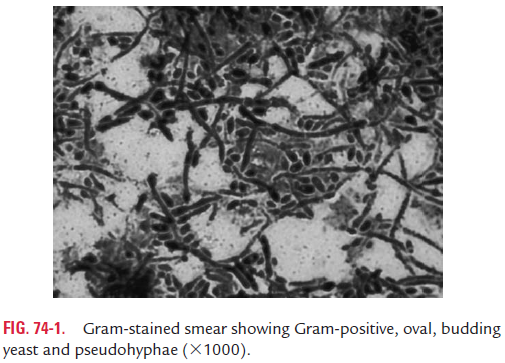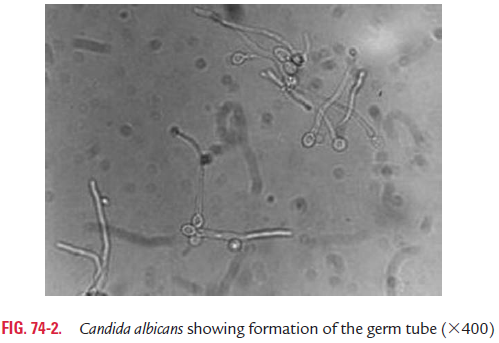Chapter: Microbiology and Immunology: Mycology, Fungi: Opportunistic Fungal Infections
Laboratory Diagnosis - Candida albicans Infections
Laboratory Diagnosis
◗ Specimens
These include exudates or tissues for microscopy obtained from skin or nails examined by microscope for demonstration of pseudohyphae or budding yeast cells of Candida.
◗ Microscopy
Gram-stained smear of the exudates or tissue shows Gram-positive, oval, budding yeast and pseudohyphae (Fig. 74-1, Color Photo 65). Since Candidais found as a part of normal flora on normal skin or mucosa, only the presence of large numbers of Candida is of significance. Demonstration of pseu-dohyphae indicates infection, and tissue invasion is of more diagnostic value.

◗ Culture
Culture on Sabouraud’s dextrose agar (SDA) produces typical creamy white, smooth colonies. Different Candida species are

identified by their growth characteristics, sugar fermentation, and assimilation tests. Germ tube is a rapid method for identi-fication of C. albicans andCandida dubliniensis. This test depends on the ability of C. albicans to produce germ tube within 2 hours when incubated in human serum at 37°C. This phenomenon is called Reynold–Braude phenomenon (Fig. 74-2, Color Photo 66). Chlamydospores are typically produced by C. albicans on corn-meal agar at 25°C, but not by other Candida species. Moreover, CHROM agar allows for the presumptive identification of several Candida species by using color reaction in specialized media, thereby showing different colors of the colonies depend-ing on the Candida species. Different Candidaspecies can also be identified with more accuracy by biochemical assays, such as AP120C and AP131C. These assays evaluate the assimilation of various sugars for identification of different fungal species.
◗ Nonculture Candida detection tests
These include (a) Candida mannan assay, (b) Candida heat-labile-antigen assay, (c) D-arabinitol assay, (d) D-inositol assay, and (e) 1,3-beta-D-glucan assay. Beta-D-glucan assay is a broad-spectrum test that detects Candida as well as Aspergillus, Fusarium, Acremonium, and Saccharomyces species. This test depends on the principle that beta-D-glu-can is a component of the cell wall of these fungi, which can be detected by its ability to activate factor G of the horse-shoe crab coagulation cascade. This test is a highly specific and sensitive test.
◗ Immunological tests
Serological tests are not that useful in diagnosis of patients with candidiasis because antibodies against Candida appear in sera of patients as well as in that of normal persons. Skin test with Candida antigen is a delayed hypersensitivity skin test, which isused as an indicator of functions of the CMI. The skin test is uniformly positive in immunocompetent adults and indicates that the person has intact CMI. The skin test is negative in indi-viduals who have deficient CMI. Such a person is anergic and is negative to other skin tests, such as purified protein derivative (PPD) skin test for tuberculosis.
Related Topics